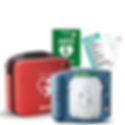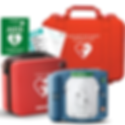top of page

Philips Defibrillators
In 2016 Philips celebrated the 20th anniversary of the HeartStart range of public access defibrillators, with the goal of raising awareness, and celebrating the achievement of reaching the milestone of 1.5 million sales globally of the HeartStart range at that point in time.
Philips defibrillators have played a major role in making AEDs available for sale over the counter without a prescription, with September 2004 becoming a pivotal moment, when the HeartStart range of Philips defibrillators were granted FDA clearance in the USA to be able to sell to home users without prescription.
As of 2015 the HeartStart range were helping save lives in many various environments, such as:
- On board 80% of major airlines in the USA
- Regional airlines, international carriers, and airports
- 43% of professional sports teams
- 85% of Fortune 500 companies
Why is a Philips defibrillator important?
In today’s times whilst we battle with the ongoing effects of COVID-19, a defibrillator can play an important role for members of the community who have leftover heart damage caused by COVID-19. Philips have collated a number of statistics which illustrate the potential impact of COVID-19 on a weakened heart:- 78% of people diagnosed with COVID-19 showed evidence of heart damage caused by the disease weeks after they have recovered.
- Arrhythmia is a top 3 risk of viral infections. People with COVID-19, SARS, MERS and influenza are at a major risk for arrhythmias (heartbeats that are too fast, slow or irregular)
- Cardiac complications of COVID-19 are equal to those of SARS, MERS, and influenza combined
- 21% of ICU patients globally, hospitalized with COVID-19 had atrial fibrillation
Philips HeartStart HS1 and HeartStart FRx
The Philips HeartStart range are designed to be easy to use, and feature clear audible instructions, and visual icons to guide the user every step of the way. With an increasing number of Philips defibrillators purchased for the home and work environment, a device that is easy to use and understand is a benefit in an emergency.Both the Philips HS1 and FRx are designed to be compact and have a simple form factor and design to make it very easy to grasp. A quick glance at the front of either of these models will feature a picture of an outline of a patient which show exactly where the pads need to be placed.
Weight becomes an important factor in design, when used in a multitude of applications, such as carried in a sports bag, a portable First Aid Kit, for personal use when travelling. The HeartStart HS1 weighs only 1.5kg, and the HearstStart FRx weight only 1.6kg.
Each of these models of Philips defibrillators come with adult pads, that can be used on ages 8 and up, and a red carry case. Paediatric pads can be purchased separately for the HS1, a child key can be purchased separately for the FRx. When these consumables have been applied, the defibrillator will decrease the shock delivered to a child.
Which Philips Defibrillator is for me?
Philips make the choice easy when it comes to identifying which is the most suitable. Both models of Philips defibrillators in Australia have a similar feature set, with a key difference being the IP rating.The higher the IP rating, the more resistance it provides to shock, dust, and splashes of water. HS1 features an IP21 rating making it suitable for home or office, whilst the FRx’s IP55 rating may benefit industries such as construction.
Our Resources Page contains links to brochures and demonstrations videos if you would like to see more, alternatively feel free to give us a call, we are here to help.
bottom of page
















